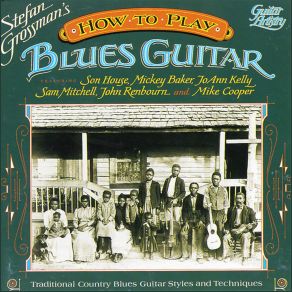How To Play Blues Guitar
Download links and information about How To Play Blues Guitar by Stefan Grossman. This album was released in 1966 and it belongs to Blues genres. It contains 23 tracks with total duration of 01:10:19 minutes.

|
|
|---|---|
| Artist: | Stefan Grossman |
| Release date: | 1966 |
| Genre: | Blues |
| Tracks: | 23 |
| Duration: | 01:10:19 |
| Buy it NOW at: | |
| Buy on iTunes $9.99 | |
| Buy on Amazon $9.49 | |
Tracks
[Edit]| No. | Title | Length |
|---|---|---|
| 1. | Yonder Comes the Blues | 5:23 |
| 2. | Police Dog Blues | 1:50 |
| 3. | Easy Street | 3:43 |
| 4. | Ragtime Mama Blues | 1:56 |
| 5. | Corrina, Corrina | 2:38 |
| 6. | If You Haven't Any Hay, Don't Get On Down the Road | 2:38 |
| 7. | Man of My Own | 3:13 |
| 8. | Assassination of John Fahey | 4:15 |
| 9. | Moon Goin' Down | 3:51 |
| 10. | Ragged and Dirty | 1:44 |
| 11. | Crow Jane | 1:48 |
| 12. | Pallet On Your Floor | 2:20 |
| 13. | Mississippi Blues #3 | 3:25 |
| 14. | New Pony Blues | 3:01 |
| 15. | You Got the Pocket Book, I Got the Key | 1:46 |
| 16. | Someday Baby | 3:23 |
| 17. | Juicy Lucy | 2:52 |
| 18. | Hard Time Killin' Floor | 4:00 |
| 19. | Belzona Blues | 3:19 |
| 20. | Oh, Babe Ain't No Lie | 3:07 |
| 21. | Special Rider Blues | 4:05 |
| 22. | Weeping Willow | 3:23 |
| 23. | Wake Up Mama | 2:39 |
Details
[Edit]Released during the peak of the mid/late-'60s folk boom, Stefan Grossman's debut, How to Play Blues Guitar, finds a young guitarist paying his respects to the music that inspired him. A student of Reverend Gary Davis (and later Skip James and Mississippi John Hurt among others), Grossman learned his blues from the source. Here, his fluency is proven through a tour of country-blues melodies and themes from standard fare like "Corrina, Corrina" to three James numbers and Grossman originals rooted in the tradition. He is joined by an amicable cast of instrumentalists and vocalists that share the stage on the majority of the material. The most suited of the group is multi-instrumentalist Sam Mitchell who fleshes out Grossman's effortless, syncopated fingerpicking with ever pertinent melodies from his own mandolin, fiddle, and slide guitar. The vocal tracks that make up the bulk of the performances are fine, though rarely more than reverential, ranging from the authentic replications of Jo Ann Kelly to the dry but steady work of Mike Cooper and Mickey Baker. The notable exceptions are the contributions from Delta blues great Son House on "Yonder Come the Blues" and "New Pony Blues." Essentially a remake of "Walking Blues," the former proves that, over 30 years after he made his first recordings, the singer was still capable of wringing new emotions out of a well-worn theme. Occasional instrumentals represent Grossman's early attempts at incorporating the blues vernacular into a six-string style of his own. Though one might not know what to make of a title like "Assassination of John Fahey," the composition finds Grossman closest to achieving those ends. Though the album's 23 performances may fail to cohere as an album per se, they serve as a document of the guitarist's roots while pointing the way to his future explorations.